REGIONAL CHINESE FOOD
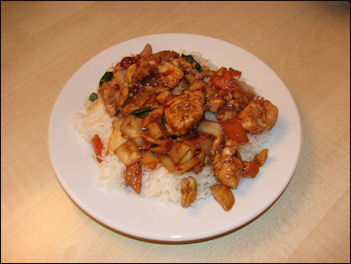
Kung Pao Chicken in LondonFood in China varies from province to province. The four main styles of Chinese cooking are Beijing (Mandarin), Cantonese, Sichuan, and Shanghai. Other well-known regional Chinese cuisines include Chaochou, Fujian, Mongolian, and Hunan styles.
Chinese cuisine is generally categorized as either "northern" or "southern." Northern dishes are typically oily, flavored strongly with vinegar and garlic, and often feature noodles or dumplings. Beijing (Peking), Tianjin (Tientsin) and Shandong (Shantung) are the best known northern styles. The food eaten at home in northern China features a lot of cabbage and potatoes. Noodles are more common in the north than rice because wheat grows better in northern China than rice. Southern Chinese cuisine often features stir-fried dishes and rice. Spicy Sichuan (Szechuan) and Hunan cooking, Chekiang cuisine, with its emphasis on fresh and tender ingredients, and Cantonese food are all examples of southern styles.
According to the Worldmark Encyclopedia of Foods and Recipes of the World: “There are four main regional types of Chinese cooking. The cooking of Guangdong province in the south is called Cantonese cooking. It features rice and lightly seasoned stir-fried dishes. Because many Chinese immigrants to America came from this region, it is the type of Chinese cooking that is most widely known in the United States. Typical Cantonese dishes are wonton soup, egg rolls, and sweet and sour pork. [Source: Junior Worldmark Encyclopedia of Foods and Recipes of the World, Gale Group, Inc., 2002]
“The Mandarin cuisine of Mandarin province in northern China features dishes made with wheat flour, such as noodles, dumplings, and thin pancakes. The best known dish from this region is Peking duck, a dish made up of roast duck and strips of crispy duck skin wrapped in thin pancakes. (Peking was the name of Beijing, the capital of China, until after the Cultural Revolution of the late 1960s. This traditional recipe is still known in the United States as "Peking duck.") Shanghai cooking, from China's east coast, emphasizes seafood and strong-flavored sauces. The cuisine of the Sichuan province in inland China is known for its hot and spicy dishes made with hot peppers, garlic, onions, and leeks. This type of cooking became popular in the United States in the 1990s.
The poem “Have They Run Out of Provinces Yet? “ goes:
“Have they run out of provinces yet
If they haven’t, we’ve reason to fret
Long ago, there was just Cantonese
(Long ago, we were easy to please)
But then food from Sichuan came our way
Making Cantonese strictly passé
Sichuanese was the song that we sung
Though the ma po could burn through your tongue
[Source: Calvin Trillin The New Yorker, April 4, 2016].
Then when Shanghainese got in the loop
We slurped dumplings whose insides were soup
Then Hunan, the birth province of Mao
Came along with its own style of chow
So we thought we were finished, and then
A new province arrived: Fujian
Then respect was a fraction of meagre
For those eaters who’d not eaten Uighur
And then Xi’an from Shaanxi gained fame
Plus some others — too many to name.
“Now, as each brand-new province appears
It brings tension, increasing our fears:
Could a place we extolled as a find
Be revealed as one province behind?
So we sometimes do miss, I confess
Simple days of chow mein but no stress
When we never were faced with the threat
Of more provinces we hadn’t met
Is there one tucked away near Tibet
Have they run out of provinces yet? .
See Separate Articles: FOOD IN CHINA: DIET, EATING HABITS AND TRENDS factsanddetails.com ; HISTORY OF FOOD IN CHINA factsanddetails.com ; FOOD, DRINKS AND CANNABIS IN ANCIENT CHINA factsanddetails.com ; WORLD'S OLDEST RICE IN CHINA factsanddetails.com ; CHINESE CUISINE factsanddetails.com ; MEAT IN CHINA factsanddetails.com ; HAIRY CRABS AND SEAFOOD IN CHINA factsanddetails.com ; VEGETABLES AND FRUIT IN CHINA factsanddetails.com ; FRUITS AND VEGETABLES IN ASIA AND SOUTHEAST ASIA factsanddetails.com ; DURIANS AND MANGOSTEENS factsanddetails.com SNACKS, DESSERTS AND SWEETS IN CHINA factsanddetails.com ; RICE, TOFU, DUMPLINGS AND NOODLES IN CHINA factsanddetails.com ; FAMOUS CHINESE FOODS AND DISHES WITH INTERESTING, FUNNY NAMES factsanddetails.com ; WEIRD FOODS IN CHINA factsanddetails.com ; BIRD'S NEST SOUP factsanddetails.com RESTAURANTS IN CHINA factsanddetails.com ; FAST FOOD AND FOOD DELIVERY BUSINESSES IN CHINA factsanddetails.com ; EATING CUSTOMS IN CHINA factsanddetails.com ; BANQUETS, PARTYING AND DRINKING CUSTOMS IN CHINA factsanddetails.com ; RICE: ITS HISTORY, AGRICULTURE, PRODUCTION AND RESEARCH factsanddetails.com; RICE AGRICULTURE IN CHINA factsanddetails.com; DUCKS, DAIRY COWS, FOIE GRASS AND LIVESTOCK IN CHINA factsanddetails.com; HOGS AND PIGS IN CHINA factsanddetails.com; FIRST CROPS IN CHINA factsanddetails.com ;
Websites and Sources: Wikipedia article Wikipedia ; Good Academic site on regional cuisines kas.ku.edu ; China.org Food Guide china.org ; Travel China Guide travelchinaguide.com ; China.org Rice Culture Article china.org ; Eating China Blog eatingchina.com/blog ; Imperial Food, Chinese Government site china.org.cn; Wikipedia article on History of Chinese Food Wikipedia ; Chopstix chopstix.com ; Asia Recipe asiarecipe.com ; Chinese Food Recipes chinesefood-recipes.com : Food Tours in China, China Highlights China Highlights Books: “Beyond the Great Wall; Recipes and Travels in the other China” by Jeffrey Alford and Naomi Duguid (Artisan, 2008) features travel stories, political analysis and recipes from Tibet, Xinjiang, Guizhou, Inner Mongolia and other places off the beaten track in China.
RECOMMENDED BOOKS: “Shark's Fin and Sichuan Pepper: A Sweet-Sour Memoir of Eating in China” by Fuchsia Dunlop and Bee Wilson Amazon.com; “The Food of Sichuan” by Fuchsia Dunlop Amazon.com; “My Shanghai: Recipes and Stories from a City on the Water” by Betty Liu Amazon.com; “The Food and Cooking of South China: Discover the vibrant flavors of Cantonese, Shantou, Hakka and Island cuisine” by Terry Tan Amazon.com; “Chinese Hot Pot Cookbook: Many Tasty Chinese Hot Pot Recipes that Could Easily Be Found in Traditional Houses in China” by Barbara Riddle Amazon.com; “Chinese Street Food: Small Bites, Classic Recipes, and Harrowing Tales Across the Middle Kingdom” Amazon.com; “Chinese Snacks: Wei-chuan Cook Book (1974) by Huang Su-Huei Amazon.com; “Dim Sum: Dumplings, parcels and other delectable Chinese snacks in 25 authentic recipes” by Terry Tan Amazon.com; “Xi'an Famous Foods: The Cuisine of Western China, from New York's Favorite Noodle Shop by Jason Wang , Jenny Huang, et al” Amazon.com; “Peking Duck Photo Book: Wonderful Images Of Peking Duck Photo Book For All Ages To Enjoy” by Rainbow Joy! Amazon.com; “Stinky Tofu Photo Book: An Awesome Photobook With Beautiful Photos And Cover For Decoration” by Rainbow Joy! Amazon.com; “Asian Ingredients: A Guide to the Foodstuffs of China, Japan, Korea, Thailand and Vietnam” by Bruce Cost Amazon.com; “The Chile Pepper in China: A Cultural Biography” by Brian R. Dott Amazon.com;
Main Cuisine Families of China
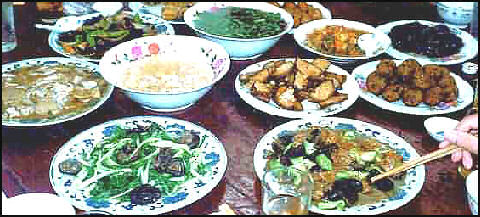
China is a country with a long history, vast territory, and multiple ethnic groups. Because of differences in climate, production, customs, cooking raw material, cooking methods and people's tastes many local styles of cuisine have formed. Local cuisines have generally developed progressively on the basis of local dishes augmented and influenced by cooking characteristics of different regions and nationalities. For example, Beijing cuisine combines the dishes of Manchu nationality, Meng nationality, Hui nationality, and Han nationality. In addition, main cuisine families are often broken down into several branches. For example, Guangdong cuisine includes Guangzhou, Chaozhou and Dongjiang dishes. How many cuisine families are there in China? Opinions vary a lot. There are generally acknowledged to be four major cuisine families, namely Sichuan cuisine, Shandong cuisine, Guangdong cuisine and Jiangsu cuisine. The other famous ones include Beijing cuisine, Shanghai cuisine, Fujian cuisine, Hunan cuisine, Zhejiang cuisine and Anhui cuisine. [Source: Liu Jun, Museum of Nationalities, Central University for Nationalities, Science Museums of China, China virtual museums, Computer Network Information Center of Chinese Academy of Sciences, kepu.net.cn ~]
"Sichuan cuisine" describes dishes mostly from Chengdu but also Chongqing, Leshan, Jiangjin, and Hechuan. Sichuan cuisine tends to use chicken, duck, and meat rather than fish. The main flavoring includes brood-bean sauce, hot pepper, Chinese prickly ash, red oil, mashed garlic, dried orange peel, and aromatic vinegar. The basic characteristics of the taste are sour, sweet, rough, hot, fragrant, heavily oiled, and strong flavor. The major cooking techniques include frying, frying without oil, pickling and braising. Some traditional famous dishes are Smoked Duck, Kung Pao Chicken, Twice Cooked Pork and Mapo Dofu. ~
"Lu cuisine" is an abbreviation for Shangdong dishes, mainly developed from the local dishes in Jinan and Jiaodong. It features careful selection of ingredients, fine cutting and slicing skills, and moderate flavor. The cooking methods include deep-frying, grilling, pan-frying, stir-frying, stewing and braising. The main flavors are salty, sour, hot, fragrant, with spring onions and garlic. The color of the cuisine is bright and usually yellow or purplish red. Traditional dishes include Jiuzhuan Large Intestine, Tang Bao Shuang Chui, Dezhou Braised Chicken, Milk Soup and Fish Maw. ~
"Yue cuisine" describes Guangdong dishes and embraces local dishes from Guangzhou, Chaozhou, and Dongjiang. Its basic characteristics include meticulous material selection and various characteristic raw materials and flavoring. Basic raw materials cover not only chicken, duck, fish and shrimps, but also wild animals, such as snake, racoon dog and monkey as well as dogs and occasionally cats. The main cooking methods are frying and stewing. The cuisine is well-known for its clean, light, crisp and fresh taste. Some typical menu items are Roasted Piglet, Salted Chicken, Fried Crisp Chicken and Oyster Sauce Beef. ~
"Su cuisine" describes Jiangsu dishes, including local dishes from Yangzhou, Nanjing, and Suzhou, which are near Shanghai. It features rigorous selection of materials, exquisite cooking, harmonious color matching, and handsome modeling. Su cuisine often features fresh river fish, lake crab, and vegetables. Its cooking methods include stewing, braising, steaming, burning, frying, and emphasizes the making of exquisite soup. Highlighted flavors have been described as fresh, slippery, soft, fat but not oily, light but not thin. The traditional dishes include Crabmeat Meatball, Squirrel with Mandarin Fish, Poached Crucian, Braised Chub Head, Crisp Eel, Phoenix Chicken, Steamed Gansi. ~
Peking (Mandarin) Cuisine
Peking Cuisine is famous for its freshness, tenderness, mild seasoning and use of many ingredients. Typical dishes include celestial beef, noodles, steamed dumplings, various kinds of steamed buns and baked bean curd. Peking duck is one of the most famous Chinese dishes. Other popular duck dishes include wind duck, made by air curing ducks outside in the winter for several months; juicy pepper-and-salt roast duck; duck and chestnut soup; and duck wings in sweet and sour barbecue sauce. Henan-style noodles with ruffled edges are served in lamb broth with lily bulbs.
Mandarin cuisine features dishes made with wheat flour, such as noodles, dumplings, and thin pancakes. Among the specialties of the region are Peking duck served with pancakes and plum sauce, sweet and sour carp, and bird's nest soup. The dumplings are often very large and can be pretty greasy. [Source: Junior Worldmark Encyclopedia of Foods and Recipes of the World, Gale Group, Inc., 2002]
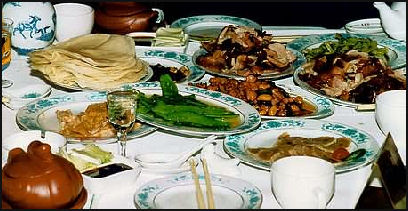
Peking duck Angie Eagan and Rebecca Weiner wrote in “CultureShock! China”: Mandarin and northern dishes includes: 1) Traditional-style bean curd with shallots (xiao cong ban dou fu) — cold tofu chunks blended with soy sauce, vinegar and sesame dressing and seasoned with chopped spring onions); 2) Empress dowager’s beef (ci xi tai ho niu rou) — sliced preserved beef seasoned with five spices; 3) Candy vinegar cabbage mound (cu liu bai cai) — pickled Chinese cabbage marinated in sweet and sour sauce, and topped with spicy peppers; 4) Boiled peanuts (shui zhu hua sheng) — served with chopped peppers after being soaked in brine and seasoned with star anise; 5) Stir-fried mutton with spring onion (cong bao yang rou) — Thinly-sliced mutton cooked till tender with sliced spring onions in a hot wo; and 6) Dumplings (jiao zi) — A mainstay of northern cuisine: meat and/or vegetable-filled dumplings that are eaten by dipping into a sauce of garlic, soy and vinegar. [Source: “CultureShock! China: A Survival Guide to Customs and Etiquette” by Angie Eagan and Rebecca Weiner, Marshall Cavendish 2011]
7) Stewed chicken and mushrooms (xiao ji dunmo gu) is made with chunks of chicken cooked slowly in a clay pot with mushrooms and potatoes. The broth is a tasty light brown sauce that goes well with rice. 8) Willow of duck in a nest (ya si yao guo) comprises slivers of duck meat sautéed with cashews, onions and peppers, served with a spicy sauce. The mixture is scooped into a nest made of deep-fried string potatoes. 9) Stir-fried cabbage in sweet and sour sauce (cu liu bai cai) features cabbage cooked in dark brown vinegar, lightly sweetened with sugar.
See Separate Article FAMOUS CHINESE FOODS AND DISHES WITH INTERESTING, FUNNY NAMES factsanddetails.com
Shandong Cuisine
Shandong Cuisine from Shandong province on the east coast of China southeast of Beijing is salty and uses a lot of spring onions and garlic and soy cause. Seafood dishes, clear soups, offal dishes and sweet and sour flavorings are common. Common dishes include stir-fried clams and braised abalone, bird’s nest soup, shredded chicken and sea cucumber with meatballs The dish associated most with Shandong is Yellow River carp in sweet and sour sauce with carp from the Zhengzhou region of the Yellow River. Shandong dumplings are fat and round. Qingdao, a city in Shandong, features dumplings with a slightly bitter taste produced by thistle tops.
 Shandong cuisine is one of the eight great traditions and major cooking styles of Chinese cuisine. It can be divided into inland Shandong cuisine (e.g. Jinan cuisine); the seafood-centered Jiaodong cuisine in the peninsula; and Confucius's Mansion cuisine, an elaborate tradition originally intended for imperial and other important feasts.
Shandong cuisine is one of the eight great traditions and major cooking styles of Chinese cuisine. It can be divided into inland Shandong cuisine (e.g. Jinan cuisine); the seafood-centered Jiaodong cuisine in the peninsula; and Confucius's Mansion cuisine, an elaborate tradition originally intended for imperial and other important feasts.
Shandong Cuisine is regarded as the foundation for the cuisine of North China. Local chefs in Shandong are skilled at preparing delicious dishes by stir-frying, boiling, frying, braising and other cooking techniques, which feature overall excellence in color, smell, taste and shape. Jinan Cuisine, Jiaodong Cuisine, and Kong Family Cuisine are three major branches of Shandong Cuisine, each having its own unique characteristics.
Jinan Cuisine is represented by a number of dishes, such as Pucai in Milky Soup, Sweet and Sour Carp from Daming Lake, and Stir-fried Kidneys Among the representative dishes of Jiao dong Cuisine are Steamed Red Snapper with Clear Soup, Tianjing Sea Cucumbers and Quick-fried Conches. Kong Family Cuisine includes things like “Going to Court with a Son” (a duck with a baby duck) and Immortal Duck.
Confucian Cuisine: on the UNESCO Intangible Cultural Heritage List?
Confucius family cuisine was included on China’s national intangible cultural heritage list in 2011 and is is being considered for placement on the UNESCO Intangible Cultural Heritage List. Xinhua reported: “A committee established at the 5th Asian Food Study Conference in the ancient thinker’s hometown [Qufu, Shandong province, China] is aiming to apply to the United Nations Educational, Scientific and Cultural Organization in three years’ time for the Confucius family cuisine to be recognized.
“The cuisine developed as a result of visits by China’s emperors, high-ranking officials and other distinguished guests to the philosopher’s home. The many banquets, ceremonies and royal commemorations there gave the family the opportunity to develop its own cooking style for formal occasions. “Cooking Confucius family cuisine is complex, labor-intensive and demands great attention to detail, ” said chef Wang Lingtao.
“The most complex banquet consisted of 196 dishes served on special silvered porcelain plates, and dining etiquette and manners have been passed down by Confucius’ descendants for more than 2,000 years, Wang said. In ancient times, chefs at the Confucius household passed on their recipes only to descendants or apprentices but now it is hoped the recipes can be made public so they can be preserved.[Source: Xinhua Shanghai Daily, October 19, 2015]
Soup Dumplings and Other Favorites from Northeast China
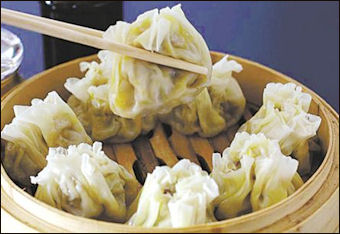
Northeast Chinese dishes include frozen melons, bread, vanilla ice cream, stewed moose nose with mushroom, Mongolian hot pot, "yellow flower" (chopped lily stalks), white fungus soup, monkey-leg mushrooms, Harbin potato-eggplant salad, pheasant shashlik. Near Russia dishes made with fatty meat, potatoes, rice gruel, stuffed cabbage, and green peppers covered in gravy are available.
Reporting from a restaurant in Tianjin famous for its soup dumplings, Seiichiro Takeuchi wrote in the Yomiuri Shimbun, Chinese dumplings are called baozi in China and are a daily food for Chinese people. Goubli, an old restaurant established in Tianjin in 1858, is regarded as the national brand. The bun, only five centimeters in diameter, is visually appealing. When you bite into it, pork soup with the scent of ginger fills your mouth. Its filling, seasoned with soy sauce, is encased with the thick skin. Great skill is required to quickly wrap up the bun by creating about 20 ruffles to seal in the center. “At the restaurant, this cooking procedure is entrusted only to skilled staff,” a 25-year-old employee said at Goubli’s main restaurant. The restaurant serves a set of eight kinds of dumplings with a variety of fillings such as meat, seafood and vegetables for 120 yuan (about $10).” Tianjin is a couple hours by train from Beijing. [Source: Seiichiro Takeuchi, Yomiuri Shimbun, January 27, 2015]
Reporting from Shenyang in northeast China, Kazuhiko Makita wrote in the Yomiuri Shimbun, “Spring pancakes” are a dish that serves up such tasty fillings as stir-fried vegetables, meat and eggs wrapped inside of a lightly baked, crepe-like flour shell. Called chunbing in Chinese, the traditional food is commonly found in the northeastern part of China. As “chun” means spring and “bing” means pancake, the dish is customarily eaten on Lichun, the holiday marking the beginning of spring. [Source: Kazuhiko Makita, Yomiuri Shimbun, November 25, 2014]
Chunbing Dawang Zongdian, a restaurant in central Shenyang, is always crowded with locals. The restaurant’s standard fillings for the dish are jingjiangrousi, shredded pork sauteed in a salty-sweet fermented soybean paste, which costs 24 yuan (about $3.50) and stir-fried bean sprouts and scallions, which are priced at 14 yuan (about $2.25) The fillings are richly flavored so that they are delicious when eaten wrapped inside thin flour shells that are individually baked in the kitchen. The restaurant offers about 30 different kinds of fillings for the dish. The best part of spring pancakes is ordering a wide variety of fillings and enjoying different tastes by selecting fillings from the plates that are spread out all over the table.Speech
Shanghai Cuisine
Shanghai is famous for its fish and seafood dishes. Shanghai people love fish and crabs from rivers not the sea, plus they like to cook fish when it is alive. Incorporating cooking styles from other provinces, Shanghai dishes are made from steamed or stewed meat or seafood with heavy seasonings, often cooked with a brown sauce that is slightly oily, lightly spiced and slightly sweet.
Shanghaiese cuisine emphasizes seafood and strong-flavored sauces. It uses liberal amounts of oil and is known for cold meat dishes as well as seafood. Shanghai specialties include fried freshwater crab with red beans; braised carp in sweet brown sauce; braised abalone; beggar's chicken; paper wrapped chicken; sweet and sour spare ribs; West Lake fish; prawns in tomato sauce; Eight Treasure duck; salted fish with bamboo shoots and mushrooms; dancing crab (marinated and sautéed crab in pepper sauce); bullfrog; and braised beef. Popular Shanghai snacks include steamed rice stuffed in a lotus leaf; pot stickers (pan fried buns); steamed dumplings filled with pork, mushroom and scallions; and crab and pork dumplings. Hongshaorou is a sweet and fatty braised-pork dish that is a Shanghainese favorite

Angie Eagan and Rebecca Weiner wrote in “CultureShock! China”: Shanghai cuisine favorites include: 1) Drunken chicken (zui ji) — Tender pieces of parboiled chicken marinated in Shaoxing wine; 2) Bean curd and mushrooms (kao fu) — Spongy bean curd blended with wood ears, golden rod and peanuts, marinated in a sweet brown sauce; 3) Preserved bamboo shoots and soy beans (you men sun mao dou) — Lightly-cooked shreds of bamboo mixed with soybeans, laced with light sesame sauce; 4) Shanghai hairy crabs (shang hai xie rou) — A delicacy in the fall, Shanghai’s special hairy crabs are boiled and served dipped in a vinegar sauce; 5) Greens with winter bamboo (dong suan ta cai) — Green vegetables stir fried with bamboo slivers; 6) Pan fried scallion cakes (cong you bing) — A thin pancake infused with scallions and dusted with sesame seeds on the top; 7) Shanghai stir-fried noodles (shang hai chao mian) — A lunchtime favorite: stir-fried noodles with pork shreds, mushrooms and green vegetables, laced with soy and sesame sauce; and 8) Steamed buns (xiao long bao) — Meat steamed in bite-sized buns, cooked until it has a delicate skin that melts in your mouth when you bite into it. [Source: “CultureShock! China: A Survival Guide to Customs and Etiquette” by Angie Eagan and Rebecca Weiner, Marshall Cavendish 2011]
9) Freshwater shrimp (qing chao he xia ren) is another Shanghai favorite. Small freshwater shrimps are peeled and quickly sauteed over hot fire. Eaten by dipping in black vinegar sauce. 10) Salt and pepper spare ribs (jiao yen pai gu) are pork ribs marinated in wine, soy sauce, garlic and sesame oil, and deep fried. They are served with loose salt and pepper next to them. 11) Boneless eight treasures stuffed duck (ba bao jiang ya) is An entire duck deboned and stuffed with bamboo shoots, peas, mushrooms and sticky rice. 12 Home-style pork in brown sauce (wai po hong shao rou) comprises chunks of pork that are half fat and half lean meat, cooked slowly until extremely tender in soy sauce, ginger, Shaoxing wine, sugar and star anise. Served with hard-boiled eggs and bean curd twists. 13 A related dish of Shanghai fame is braised pork knuckles (ti pang), which is a whole piece of meat on bone cooked slowly in the same sauce until it is about to fall off the bone.
Shanghai Area Freshwater Crabs
Shanghai is famous for its freshwater crabs. Regarded as an autumn, winter and cold weather delicacy, the crabs are indigenous to rivers and lakes in the Shanghai and Kuangchou regions and are raised in fish farm ponds, often filled with Yangtze River water. In markets the crabs are sold live with their legs bound together with rubber bands. Smaller crabs are said to be tastier than large ones. Freshwater crabs are said toe tastiest in October or November. See Fish and Seafood
Offering a guest some fresh crab is regarded as the best possible form of hospitality in Shanghai. Chinese not only eat the meat the also enjoy consuming the crab innards (known as “kanimiso”), which is found under the carapace. The eggs in females is also eaten. Much of the time the crab is prepared in a bamboo steamer. The carapace is opened by hand and the meat and kanimiso is plucked out with chopsticks and dipped in soy sauce with vinegar and ginger.
Drunken crabs is a specialty that needs to be ordered in advance. The crabmeat and roe are soaked in Chinese wine-based marinade for at least four days. The marinade includes crushed garlic, ginger, leeks, pepper, sugar and star anise. After the soaking the meat and roe take on a gelatinous texture and have a rich, sweet, peppery taste. A banquet featuring Shanghai fresh water "hairy crab" from the Yangtze River can set one back $1,000 or more.
See Separate Article HAIRY CRABS AND SEAFOOD IN CHINA factsanddetails.com
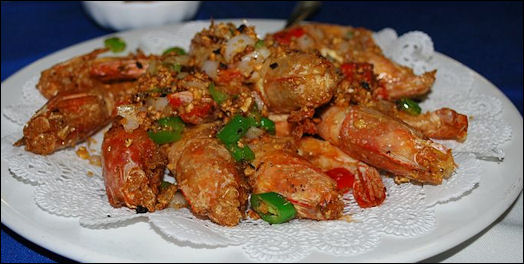
shrimp mango rice
Zhejiang, Anhui and Jiangsu Cuisine
Zhejiang, Anhui and Jiangsu Provinces are near Shanghai. Zhejiang and Jiangsu Provinces — known as “yu mi zhi xiang” (“land of fish and rice”) for their soil, water and climate — are famous in China for their regional cuisines. One Hangzhou chef told The New Yorker, “Our flavors are as varied as the Sichuanese, but they tend to be light and bright, without the heavy spiciness. We emphasize regional produce, and the essential tastes of raw materials.” Zhejiang and Jiangsu dishes use little oil, salt sugar or starch and not surprisingly are regarded as very healthy.
Jiangsu Cuisine is known for its sweet, vinegar-laced lake and river fish, shellfish and rice dishes. Famous dishes include West Lake fish in vinegar (made with a live fish thrown in the stewing pot), a soft shell turtle stew known as "The King Bid Farewell to his Consort,” Nanjing pressed-salted duck and squirrel-shaped mandarin Fish. Lotus roots stuffed with glutinous rice (gui hua tang ou) is infused with osmanthus flowers and covered in a sugary syrup.
Zhejiang Cuisine is known for its light-tasting, delicately-seasoned seafood and vegetable soups and dishes. Among the important ingredients are sugar, rice wine, bamboo shoots and distiller’s grain vinegars. Zhenjiang favorites include Sour West Lake fish, steam-fried yellow croaker and wild mushroom casserole in a fragrant broth, Longjing shelled shrimps, spring bamboo shoots braised in oil, Yangzhou fried rice, and glutinous rice balls.
Laura Kiniry wrote in Atlas Obscura: Suzhou dishes are “known for their subtle flavors and an emphasis on ingredients including braised pork, bamboo shoots, and a paste made from broiled and stir-fried eels. Entrées are highly flavorful and typically sweeter than other regional Chinese cuisines, with a stylized look that at once embodies visual storytelling and distinct culinary craftsmanship. [Source: Laura Kiniry, Atlas Obscura, September 21, 2018]
Anhui Cuisine is known for mixing the cuisines of the regions that surround it: hot and spicy from Sichuan, oily and sweet from Jiangsu and salty from Shandong. Small pieces of sugared candy and salted foods are often used as spices. Many famous dishes are made with stone frogs and soft-shelled turtles. Famous dishes include Huangshan Fragrant Fish, Bagong Mountain tofu rolls, Three Rivers gumbo, stewed soft-shell turtle with sweet ham and steamed Huangshan Stone Frog.
Cantonese Cuisine
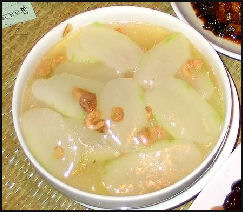
Cantonese cuisine from Guangzhou (Canton) in Guangdong Province in southern China near Hong Kong is known for its subtle flavors and fresh ingredients and the lightness and variety of the lightly spiced but colorful dishes, which are often stir-fried to preserve the texture and flavor. Cantonese dim sum and seafood are popular throughout the world. A Cantonese meal can range from a quick snack from a food stall to an elaborate 12-course banquet, featuring delicacies such as shark fin soup, abalone, bird's nest soup, roast suckling pig, and deep-fried prawn paupiette. People from Guangzhou and Guangdong are also famous for having a fondness for eating wild animals, endangered species and snakes and rats, which they like to eat fresh. See Weird Food
Cantonese cooking features a lot of rice and fresh vegetables. Food is parboiled, steamed, or quickly stir fried. The Cantonese love seafood, and freshness is of the utmost importance. According to a popular Cantonese saying "if it doesn't move, we don't eat it." Most seafood restaurants have tanks filled with fish and other sea creatures, with patrons picking out what they want and telling the waiters how they want it prepared. Cantonese prefer their fish steamed, which they say brings out freshness. Fish is also grilled, poached, fried and broiled.
The Winter Solstice Festival (“Dongzhi”) is an important festival in China typically celebrated on or around December 22nd. This tradition dates back to the Han Dynasty (206 B.C.-A.D. 220) when both government officials and commoners would have a day to reunite with their families. In southern China, particularly Hong Kong, the Winter Solstice Festival is a time for family members to meet, gather for dinner, and have tangyuan, a type of small dumpling made of glutinous rice flour and stuffed with either a peanut paste, red bean paste, or sesame paste. Due to the round shape of these dumplings and of the serving bowls, tangyuan symbolizes togetherness, fullness, and completeness—things associated with the Winter Solstice Festival. [Source: YestoCooking.com. December 21, 2012]
Chaochou cuisine is food from Chachou, a district within Guangdong (Canton) province known for its own unique style. Chaochou food has been described as gutsy and hearty, and chefs from the region pride themselves on their vegetable-carving skills. Designs of flowers, birds and dragon are featured at many Chaochou-style banquets. Favorite Chaochou dishes include shark fin soup, steamed goose in soy sauce and various seafood dishes. Chaochou restaurants usually stay open late.
Cantonese Dishes
In many ways what the world knows as Chinese food is Cantonese cuisine. Popular Cantonese dishes include sweet and sour pork, wonton soup, egg rolls, shark fin soup, bird's nest soup, barbecued pork ribs, diced chicken with walnuts, slow-cooked soup, roast goose in pickled plums, Cantonese stuffed bean curd,prawns in chili sauce, roast pork ribs, steamed chicken in peanut oil, fried prawns with salt, and diced beef with garlic. Because many Chinese immigrants to America came from Canton, Guangdong and southern China, the types of Chinese cooking found there are the most widely known in the United States.
Popular seafood dishes are made with prawns, garoupa (a white, meaty, slightly sweet fish), squid, and octopus. They include fried octopus, steamed prawns in garlic sauce, steamed garoupa with ginger and scallions, fried shrimp balls, baked lobster with cheese sauce, three-colored lobster and dragon and tiger fight. Abalone, crab and lobster are often extremely expensive. Favorite deserts include fresh melon and rice flour coconut balls.
Angie Eagan and Rebecca Weiner wrote in “CultureShock! China” Cantonese favorites include 1) Wonton noodle soup (yun tun tang mian) — Meat-filled dumplings and strands of long thin noodles served in a broth and seasoned with fresh chopped spring onions; 2) Sweet and sour pork (gu lao rou), — Familiar at Chinese restaurants in the West, deep-fried chunks of pork served in a sweet sauce of ketchup, sugar and vinegar; 3) Stir-fried beef with onion (cong bao niu rou) — Strips of steak stir fried in oyster sauce with onions; and 4) Crispy chicken (jiao yan cui ji) — Barbecued chicken that is crisp on the outside and tender on the inside. Served with salt, pepper and soy sauce on the side. 5) Congee (zhou) is rice cooked until it is soupy and seasoned with different meats and vegetables. This is a favorite breakfast dish in China.. Egg custard tarts (dan ta) are small pastries cooked with a slightly sweet egg custard inside. A legacy of the Portuguese influence on south China. [Source: “CultureShock! China: A Survival Guide to Customs and Etiquette” by Angie Eagan and Rebecca Weiner, Marshall Cavendish 2011]
See Separate Article FAMOUS CHINESE FOODS AND DISHES WITH INTERESTING, FUNNY NAMES factsanddetails.com
Recipes for Wontons, Wonton Soup and Eggdrop Soup
Wonton Soup Ingredients: ½ pound pork or beef, ground; 1 Tablespoon scallions, finely chopped; 1 egg, beaten; 1 teaspoon salt; 1 Tablespoon soy sauce; 1 Tablespoon sugar; 1 teaspoon sesame oil (optional); 1 Tablespoon water; 2 packages wonton skins; 3 cans (15 ounces each) chicken or other broth (about 6 cups). [Source: Junior Worldmark Encyclopedia of Foods and Recipes of the World, Gale Group, Inc., 2002]
Wonton Soup Directions: 1) Mix ground pork (or beef), scallions, egg, salt, soy sauce, sugar, sesame oil, and water in a bowl. 2) Place 1 teaspoon of meat mixture in the center of a wonton skin. 3) Moisten the edges of wonton skin with water and fold it to form a triangle. Press the edges together to seal. 4) Fill and fold the rest of the wonton skins. ) Bring a large pot of water to a boil to cook the wontons. 5) In another pot, heat the broth. (Wontons will be cooked first in the boiling water and then added to the broth. 6) Add a few wontons at a time to the boiling water, giving them room to float freely. Cook over medium heat 8 to 10 minutes. 7) Add the cooked wontons to hot broth. Use about 3 dozen wontons for 6 cups of broth. Recipe makes 48 wontons.
Fried Wonton Directions: 1) Prepare wontons according to recipe for Wonton Soup (or purchase packaged wontons). 2) Fry in hot oil until golden brown and crispy. 3) Drain the wontons on a paper towel and serve hot with duck sauce (sweet and sour sauce).
Eggdrop Soup Ingredients: 1 egg, room temperature; 1 can chicken stock (about 2 cups); ½ teaspoon salt; ½ teaspoon sugar; 1 teaspoon soy sauce, thin; Large scallions cut into tiny circles (green parts only).
Eggdrop Soup Directions: 1) Remove the egg from the refrigerator and allow it to come to room temperature. 2) Beat the egg lightly in a bowl. 3) Put the stock in a saucepan or wok and bring to a boil. 4) Lower heat to the lowest setting. 5) Hold the bowl with the beaten egg above the pan with the simmering broth. 6) Slowly and carefully pour the egg into the broth in a very thin stream. 7) Hold a fork in your other hand, and trace circles on the surface of the broth, drawing out long filmy threads of egg on the surface of the broth. 8) Simmer for about 1 minute, and then remove the saucepan from heat and cover for 45 seconds. 9) The egg should be set in tender flakes. 10) Add salt, sugar, and soy sauce, and sprinkle the scallions on top. 11) Stir the mixture two or three times. 12) Transfer to individual soup bowls and serve. Serves 2.
Sichuan Cuisine
Sichuan (Szechuan) is famous for its spicy, oily and richly-flavored dishes made from chicken, pork, shellfish and river fishes and featuring sauces made with hot Sichuan peppers, star anise, garlic, scallions, onions, leeks, fennel seed, rice wine, soy, ginger, vinegar, soy bean pastes and Sichuan Well Salt (a distinctly flavored salt mined in Sichuan in places such as Ziyong) There are many Sichuan and Hunan restaurants in the U.S.. Although the dishes they serve are spicy and they contain Sichuan peppers they are different from the Sichuan dishes you find in China, which in turn are often different from those found in Sichuan. Spicy noodles (dan dan mian) are popular though out China.
Sichuan dishes are often are quite salty and are spiced with tongue-numbing Sichuan pepper (derived from peppercorns from a prickly ash tree) and are known for their multiple rather than singular flavors. It is said that within Sichuan cooking there are 23 flavors and 56 cooking methods. Fragrant, Sichuanese dan dan noodles are best when “ma la” (“hot and numbing”).
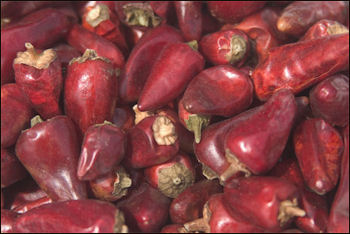
Sichuan peppers: Facing heaven chiliSichuan cooking has been famous in China for centuries. One ancient document traces its origin back to the 7th century B.C.. A multi-volume Tang Dynasty (A.D. 618-907) record catalogued 1,328 Sichuan dishes. The liberal use of spices dates back to a time when the poor consumed things like chicken feet, fish heads and intestines and used hot peppercorns and other seasonings to mask the taste. A good book on authentic Sichuan cooking is “Land of Plenty: A Treasury of Authentic Sichuan Cooking” by Fushsia Dunlop (W.W. Norton & Co., 2003).
Sichuan dishes are difficult to prepare at home because they often employ numerous steps. Smoked duck, for example, is flavored with peppercorns, ginger, cinnamon, orange peel and coriander, marinated for 24 hours, steamed for two hours, and finally smoked over a fire made with charcoal, camphor wood and tea leaves.
Sichuan Dishes
Among the popular spicy Szechuan dishes are chicken with peanuts; stir-fried chicken and hot sauce; sizzling rice and chicken; eggplant Szechuan style; squid rolls with dried pepper; chicken baked in salt and served with peanut oil sauce; salt-baked chicken livers; stir-fried pork and hot sauce; “dan dan” noodles (noodles, pork cooked in a hot sauce); “ma po dofu” (a famous Chengdu dish made with dried tofu, and a hot sauce made with chilies and Sichuan peppers); hot and sour soup (filled with Sichuan pickles and strips of pork), spicy tea mushrooms pork pot; red hot sesame noodles; duck smoked in camphor and tea; Man and Wife meat slices; Pockmarked Lady’s bean curd; crispy roast duck, and Husband and Wife pork lung slices. Shrimp with salt and garlic, frogs' legs, and smoked duck are also popular dishes.
Angie Eagan and Rebecca Weiner wrote in “CultureShock! China”: Among the marvelous Sichuan dishes are 1) Sichuan pickled vegetables (pao cai) — Vegetables marinated in vinegar, soy and hot peppers, served alone or to accent a dish; 2) Shredded chicken and green bean noodles in spicy sauce (ji si la pi) — Chicken shreds served with sesame and chili sauce over a bed of chilled green bean noodles; 3) Finely sliced pork with garlic sauce (suan ni bai rou) — Paper-thin slices of pork served in garlic and chili sauce; 4) Cucumber slices in pepper and sesame oil (qiang huang gua) — Flash-fried cucumbers accented with Sichuan peppers, served with light chili oil, Very spicy!; 5) Spicy pork ribs (xiang la pai gu) — Deep-fried pork ribs seasoned with a spicy coating of salt, pepper and Sichuan pepper; 6) Dry-fried green beans (gan bian dao dou) — Hot fried green beans seasoned with pickled black beans and pork mince; and 7) Sichuan pepper bean curd (ma po dou fu) — Soft bean curd chunks cooked slowly in a spicy brown sauce, seasoned with pork mince and spring onions. [Source: “CultureShock! China: A Survival Guide to Customs and Etiquette” by Angie Eagan and Rebecca Weiner, Marshall Cavendish 2011]
8) Spicy chicken with peanuts (gong bao ji ding) is well-loved in the West as kung pao chicken. It is made with fried chicken chunks and peanuts served in a bed of red peppers and garnished with coriander. 9) Spicy noodles (dan dan mian) is made with thin flour noodles boiled and then served with a spicy broth. Depending on the base of the sauce, it can taste nutty if the recipe uses more sesame or spicy if it uses more chili. Usually served with pickled vegetables and crushed nuts on top. 10) Hot and sour soup (suan la tang) is made with chunks of tofu, shreds of bamboo, pieces of mince pork, mushroom chunks and spring onion served in a vinegar-based broth and seasoned liberally with fine black pepper. 11) Beef slices boiled in a hot sauce (shui zhu niu rou) is beef flash cooked in a bowl of very hot oil, chilis, onion and coriander. There are hot rocks in the bottom of the dish to keep the oil hot.
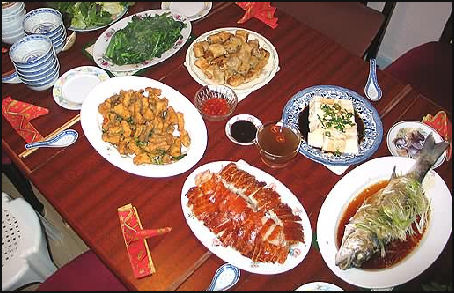
Singing the Praises of Sichuan Cuisine
Victor Paul Borg wrote in the China Daily, On a trip to China in July 2014, “German Chancellor Angela Merkel...learned to cook gongbao jiding (diced chicken cooked with peanuts, chili peppers and Sichuan peppercorns) from a cook in Chengdu, capital of Sichuan province. Presumably, Merkel's gesture was aimed at using food as a cultural bridge between the West and the East... Another reason could be the eminence of Sichuan cuisine. [Source: Victor Paul Borg, China Daily, July 12, 2014 |::|]
“I may be biased because I have lived in Sichuan, but after years of traveling and writing about food extensively I can say that Sichuan cuisine is probably the most varied and creative in the world. Sichuan cuisine owes its variety to its diverse topography and amenable climate that have fostered the farming of an impressive and rich range of spices and vegetables. Not for nothing was Chengdu honored by UNESCO as a food heritage city a few year ago. |::|
“Yet Sichuan cuisine is relatively unknown in the West... Cantonese cuisine continues to dominate the Chinese restaurant scene in the West, although many now also serve dishes from other regions, particularly the ever-popular Peking Duck and some Sichuan fair such as mapo toufu and gongbao jiding. Yet another thing that the West can learn from China is how to acquire a taste for different parts of animals, fowls, plants and vegetables. For example, people in Sichuan eat the leaves of the pea plant, and use almost all the organs and parts of animals and fowls to prepare dishes - a commendable practice to prevent waste at a time when food production can hardly keep up with population growth. Perhaps when another eminent Westerner visits China, he or she will try one of my favorite dishes: fried duck's tongue, a premium dish in many upscale Sichuan restaurants, or even duck's brain, which tastes as good as foie gras.” |::|
Hunan Cuisine
Hunan cuisine is considered to be the best and spiciest in China. Similar to Szechuan cuisine but oilier and richer, Hunan dishes are often spiced with garlic and scallions, and have a hot and sour, or sweet and sour taste. The original sweet and sour sauce is said to have come from Hunan. The Hunan region has traditionally been known for bountiful harvests and large numbers of wild animals.
Common spices include fresh star anise, fennel seed, coriander, chili bean paste, garlic and a wide variety of chilies and peppers that are used to enliven mundane things like mashed eggplant and smoked and cured meat. Many dishes have distinctive “two-layer” sauces and are prepared through steaming, pot roasting or “slow” cooking. Watch out for the “strange flavor” sauces. They can be quite intense and make a beer drunken after eating them taste like water.
Popular Hunan dishes include minced pork in cantaloupe (pork and scallions steamed in a half cantaloupe); honey ham (sliced raw ham steamed with honey and black dates; and steamed again with sugar and served with bread). Exotic Hunan dishes are made from frog's legs, turtle, duck, tripe, and sea cucumbers. One dish that doesn’t sound very good but is said to be quite tasty is steamed fish heads in chili sauce. Soup and vegetables are usually served with meals, and often there is no rice or noodles.
Fujian and Guanxi Cuisine
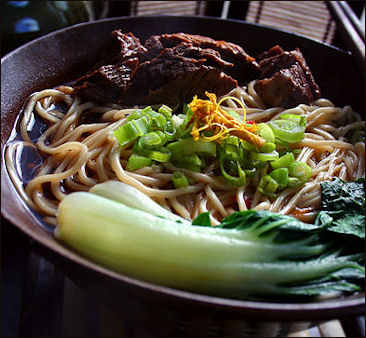
Fujian cuisine (Taiwanese Cuisine) is dominated by seafood and noted for its large variety of soups. Influenced by cooking-styles from Japan, it is often served at restaurants with large tanks containing live shrimps, lobsters, crabs and fish, with customers often choosing the particular fish or sea creature they want.
Fujian cooking is also known as “Min food” and is the most common type of cuisine found in Taiwan. It is generally light, simple, easy-to-prepare and liberally spiced with ginger and frequently cooked in pork fat. Fujian soups are usually made with seafood, turtle, shark's fin or clams. The seasonings are sweet and mild. One flavoring unique to the region is the so-called “red distillers grain” — glutinous rice fermented for more than a year with red yeast in special container. It has a sharp sweet and sour flavor.
Favorite Fujian dishes include steamed rice with crab; raw fish and shellfish wrapped around pickles; crispy pork in the shape of lychee balls; flash-boiled squid in chicken soup; yeast cakes preserved in jelly; and Buddha Jumps Over a Wall. The latter is a rich soup that gets its name form an old saying: “It was so tasty that a monk learned to jump over a wall to get his share.” Nickle-size Fujian wontons are served in a clear soup. “smooth fish” features finely chopped white fish mixed with potato flour and dropped pinch by pinch into the soup. [Source: Taiwan Guide, International Travel Press]
Guangxi lies in subtropical region with plentiful rain. A wide variety of livestock, fruit and vegetables are produced there the year round. These including the duck and Shanhuang chicken from the plains; Palea steindachneri, bamboo rat and a variety of wild mushrooms from hilly areas; and fresh oysters, prawns, mud crab from marine areas. Among the well-known staple and specialty products are HuanJiang Dishes, Bama miniature pigs, Lianjiang squid, Guilin Water Chestnut, LiPu taro, GuiGang lotus root, dried tangerine peel, star anise, cinnamon, and mangosteens. Some of these are essential ingredients for Gui dishes.
Gui dishes are divided into Northern Gui, Southeast Gui, coastal cuisine and ethnic dishes. Northern Gui food is known for its rich taste, strong color, stews and spicyness. Southeast Gui dishes stress fresh and tender, use a wide range of materials. Coastal food stress seasoning and color and of foods and feature several kinds of seafood. Ethnic dishes are made from local materials and emphasize affordable and unique methods of cooking.
Website: www.newpastoral.com
Cuisine from Western China
Yunnan dishes include spring rolls, crispy beef rolls, baked mushrooms and dishes caterpillar fungus chicken soup in a steam pot made with four different kinds of Yunnan mushrooms. Yunnan province is famous for the wide variety of dishes and delicacies it offers. Perhaps the fact that it is home to more than two dozen ethnic groups has something to do with it. The variety and taste of and the ingredients used in dishes can differ from town to town and even village to village, except erkuai, a culinary specialty made of rice, which is omnipresent in the entire province. There are a number of offbeat dishes, from Yunnan, including several made with insects. See Weird Food.
Western Chinese Dishes include “jiaozi” (stuffed dumplings), lamb kebabs, “nang” (flat loaves of bread), spicy Xinjiang chicken, lamb, cucumbers with red peppers, cumin-seasoned lamb kebabs, griddle-baked sesame bread, mushrooms and white fungus, “zhang cha yazi” (excellent chili duck smoked in jasmine tea, rubbed with rice wine, and air dried). Among the typical Muslim dishes are mutton, eggplant, mixed vegetables, steamed bread and rice. Grapes and variety of melons are consumed.
Angie Eagan and Rebecca Weiner wrote in “CultureShock! China”: Xinjiang food is influenced by its age-old ties to the Middle East as an ancient outpost of the Silk Road. The food in this region is typically hearty and filling, with bread, meat, rice and root vegetables frequently featured. Lamb is often a key ingredient in Xinjiang food, making it unique to the beef, pork and fish-based dishes of the east and north. Xinjiang dishes makes use of unusual spices such as cumin that are unique in Chinese cuisine. [Source: “CultureShock! China: A Survival Guide to Customs and Etiquette” by Angie Eagan and Rebecca Weiner, Marshall Cavendish 2011]
Tibetan Food eaten by ordinary Tibetans consists primarily of barley gruel, Tibetan dumplings and yak butter tea. Dishes featured at Tibetan restaurants are often made with grilled yak meat, melon, squash, wood-ear fungus, noodles, steamed buns, pig fat, and eggs cooked in yak fat. A typical meal is comprised of seaweed soup, french fries and buns stuffed with yak meat. Chinese style dishes are often made from ingredients that originated outside of Tibet.
Image Sources: Beifan.com , Perrechon blog, Nolls China website http://www.paulnoll.com/China/index.html
Text Sources: New York Times, Washington Post, Los Angeles Times, Times of London, National Geographic, The New Yorker, Time, Newsweek, Reuters, AP, Lonely Planet Guides, Compton’s Encyclopedia and various books and other publications.
Last updated October 2021
